Tocopherol derivative TFA-12 promotes myelin repair in experimental models of multiple sclerosis
- PMID: 23843531
- PMCID: PMC6618682
- DOI: 10.1523/JNEUROSCI.0774-13.2013
Tocopherol derivative TFA-12 promotes myelin repair in experimental models of multiple sclerosis
Abstract
Multiple sclerosis (MS) is an inflammatory disease of the CNS that is associated with demyelination and axonal loss, resulting in severe neurological handicap. Current MS therapies mostly target neuroinflammation but have only a little impact on CNS myelin repair. Progress toward treatments that enhance remyelination would therefore represent major advances in MS treatment. Here, we examined the ability of TFA-12, a new synthetic compound belonging to tocopherol long-chain fatty alcohols, to promote oligodendrocyte regeneration and remyelination in experimental models of MS. We showed that TFA-12 significantly ameliorates neurological deficit and severity of myelin oligodendrocyte glycoprotein-induced experimental autoimmune encephalomyelitis (EAE) in mice. Histological evaluation of mouse EAE spinal cords showed that TFA-12 treatment reduces inflammation, astrogliosis, and myelin loss. Additionally, we demonstrated that TFA-12 accelerates remyelination of focal demyelinated lesions induced by lysolecithin injections. We also found that this compound induces the differentiation of oligodendrocyte precursor cells into mature oligodendrocytes through the inhibition of the Notch/Jagged1 signaling pathway. Altogether, our data provide important proof of principle indicating that TFA-12 could be a potential therapeutic compound for myelin repair in MS.
Figures
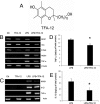
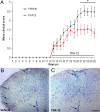

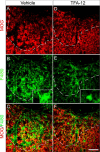
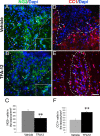
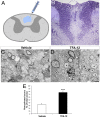
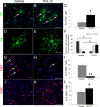


Similar articles
-
A dual effect of ursolic acid to the treatment of multiple sclerosis through both immunomodulation and direct remyelination.Proc Natl Acad Sci U S A. 2020 Apr 21;117(16):9082-9093. doi: 10.1073/pnas.2000208117. Epub 2020 Apr 6. Proc Natl Acad Sci U S A. 2020. PMID: 32253301 Free PMC article.
-
Nudging oligodendrocyte intrinsic signaling to remyelinate and repair: Estrogen receptor ligand effects.J Steroid Biochem Mol Biol. 2016 Jun;160:43-52. doi: 10.1016/j.jsbmb.2016.01.006. Epub 2016 Jan 14. J Steroid Biochem Mol Biol. 2016. PMID: 26776441 Free PMC article. Review.
-
Inhibition of CXCR2 signaling promotes recovery in models of multiple sclerosis.Exp Neurol. 2009 Nov;220(1):44-56. doi: 10.1016/j.expneurol.2009.07.010. Epub 2009 Jul 17. Exp Neurol. 2009. PMID: 19616545 Free PMC article.
-
Drug-based modulation of endogenous stem cells promotes functional remyelination in vivo.Nature. 2015 Jun 11;522(7555):216-20. doi: 10.1038/nature14335. Epub 2015 Apr 20. Nature. 2015. PMID: 25896324 Free PMC article.
-
FGF/FGFR Pathways in Multiple Sclerosis and in Its Disease Models.Cells. 2021 Apr 13;10(4):884. doi: 10.3390/cells10040884. Cells. 2021. PMID: 33924474 Free PMC article. Review.
Cited by
-
Alpha-tocopherol ameliorates experimental autoimmune encephalomyelitis through the regulation of Th1 cells.Iran J Basic Med Sci. 2016 May;19(5):561-6. Iran J Basic Med Sci. 2016. PMID: 27403263 Free PMC article.
-
Skin-derived neural precursors competitively generate functional myelin in adult demyelinated mice.J Clin Invest. 2015 Sep;125(9):3642-56. doi: 10.1172/JCI80437. Epub 2015 Aug 24. J Clin Invest. 2015. PMID: 26301815 Free PMC article.
-
Modulation of Multiple Sclerosis and Its Animal Model Experimental Autoimmune Encephalomyelitis by Food and Gut Microbiota.Front Immunol. 2017 Sep 5;8:1081. doi: 10.3389/fimmu.2017.01081. eCollection 2017. Front Immunol. 2017. PMID: 28928747 Free PMC article. Review.
-
A comprehensive review on the treatment approaches of multiple sclerosis: currently and in the future.Inflamm Res. 2019 Jan;68(1):25-38. doi: 10.1007/s00011-018-1185-0. Epub 2018 Sep 3. Inflamm Res. 2019. PMID: 30178100 Review.
-
Antioxidant Therapies in the Treatment of Multiple Sclerosis.Biomolecules. 2024 Oct 8;14(10):1266. doi: 10.3390/biom14101266. Biomolecules. 2024. PMID: 39456199 Free PMC article. Review.
References
-
- Back SA, Tuohy TM, Chen H, Wallingford N, Craig A, Struve J, Luo NL, Banine F, Liu Y, Chang A, Trapp BD, Bebo BF, Jr, Rao MS, Sherman LS. Hyaluronan accumulates in demyelinated lesions and inhibits oligodendrocyte progenitor maturation. Nat Med. 2005;11:966–972. - PubMed
Publication types
MeSH terms
Substances
LinkOut - more resources
Full Text Sources
Other Literature Sources
Medical
